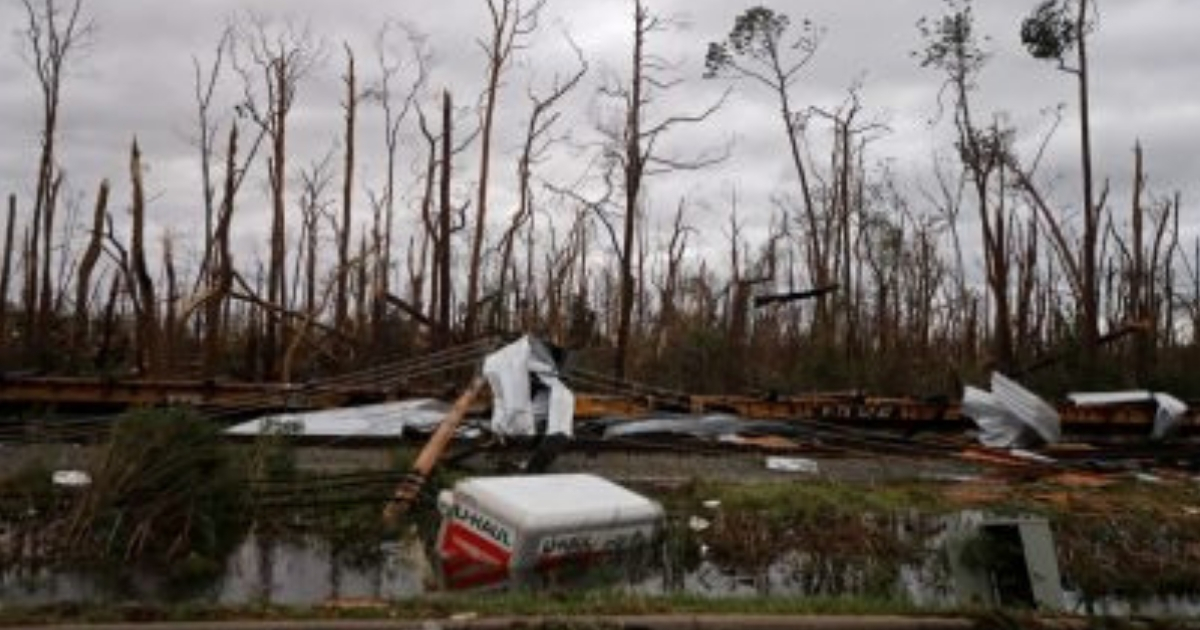
Michael Leaves Wide Path of Destruction, Turns Deadly
The third-most powerful hurricane to hit the U.S. mainland in recorded history left a wide path of destruction across Florida and Georgia, destroying homes and shopping centers and felling trees that killed at least two people.
And it’s not done yet.
Hurricane Michael finally weakened to a tropical storm on Thursday, no longer a Category 4 monster packing 155 mph winds. But it was still menacing the Southeast with heavy rains, blustery winds and possible spinoff tornadoes, soaking areas swamped by epic flooding last month from Hurricane Florence.
By 5 a.m. Eastern, Michael’s eye was about 45 miles west of Augusta, Georgia, packing top winds of 50 mph and moving at 21 mph into South Carolina, the National Hurricane Center in Miami said.
Thousands of law enforcement officers and search and rescue teams rolled out in its wake to find survivors amid the wreckage of homes where people defied evacuation orders. Michael washed away white sand beaches, hammered military bases and destroyed coastal communities, stripping trees to stalks, shredding roofs, toppling trucks and pushing boats into buildings.
It will take some time for residents of north Florida to take stock of the enormity of the disaster. Reaching the worst-hit areas wasn’t easy. The Florida Highway Patrol closed 80 miles of Interstate 10, the main east-west route along Florida’s Panhandle, to clear debris.
Many homes were ripped apart or washed away altogether in Mexico Beach, a town of 1,000 where the hurricane made landfall and the storm surge pushed lead-grey water up to the rooftops. Authorities said falling trees killed a man outside Tallahassee, Florida, and an 11-year-old girl in southwest Georgia.
An Associated Press team drove for miles and encountered extensive destruction around Panama City, just west of where the center of Michael’s eye hit the shore. Although most homes were still standing, no property was left undamaged. Downed power lines lay nearly everywhere. Roofs were peeled away and sent airborne. Aluminum siding was shredded to ribbons. Homes were split open by fallen trees. Hundreds of cars had broken windows, many turned askew by the wind. Twisted street signs lay on the ground. Pine trees were stripped into stalks and snapped off about 20 feet high.
More than 780,000 homes and businesses were without power Thursday in the wake of the storm.
Families tentatively emerged from darkened shelters and hotels to this unfamiliar and perilous landscape, under a perfectly clear blue sky, to the sounds of a Coast Guard helicopter hovering over damaged neighborhoods, beeping security alarms and the occasional sirens of police and fire department vehicles.
Vance Beu, 29, was staying with his mother at her home, Spring Gate Apartments, a complex of single-story wood frame buildings where they piled up mattresses around themselves for protection. A pine tree punched a hole in their roof and his ears even popped when the barometric pressure went lower. The roar of the winds, he said, sounded like a jet engine.
“It was terrifying, honestly. There was a lot of noise. We thought the windows were going to break at any time,” Beu said.
Sally Crown rode out Michael on the Florida Panhandle thinking at first that the worst damage was the many trees downed in her yard. But after the storm passed, she emerged to check on the cafe she manages and discovered a scene of breathtaking destruction.
“It’s absolutely horrendous. Catastrophic,” Crown said. “There’s flooding. Boats on the highway. A house on the highway. Houses that have been there forever are just shattered.”
A Panhandle man was killed by a tree that toppled on a home, Gadsden County Sheriff’s Office spokeswoman Anglie Hightower said. But she added emergency crews trying to reach the home were hampered by downed trees and debris blocking roadways. The debris was a problem in many coastal communities and still hundreds of thousands of people were also left without power.
Gov. Rick Scott said search and rescue efforts would be “aggressive.”
“Hurricane Michael cannot break Florida,” Scott vowed.
Michael sprang quickly from a weekend tropical depression, going from a Category 2 on Tuesday to a Category 4 by the time it came ashore. More than 375,000 people up and down the Gulf Coast were ordered or urged to evacuate, but it moved so fast that people didn’t have much time to prepare, and emergency authorities lamented that many ignored the warnings, thinking they could ride it out.
In Panama City, plywood and metal flew off the front of a Holiday Inn Express. Part of the awning fell and shattered the glass front door of the hotel, and the rest of the awning wound up on vehicles parked below it.
“Oh my God, what are we seeing?” said evacuee Rachel Franklin, her mouth hanging open.
Based on its internal barometric pressure, Michael was the third most powerful hurricane to hit the U.S. mainland, behind the unnamed Labor Day storm of 1935 and Camille in 1969. Based on wind speed, it was the fourth-strongest, behind the Labor Day storm (184 mph), Camille and Andrew in 1992.
The Western Journal has reviewed this Associated Press story and may have altered it prior to publication to ensure that it meets our editorial standards.
Truth and Accuracy
We are committed to truth and accuracy in all of our journalism. Read our editorial standards.
Advertise with The Western Journal and reach millions of highly engaged readers, while supporting our work. Advertise Today.











